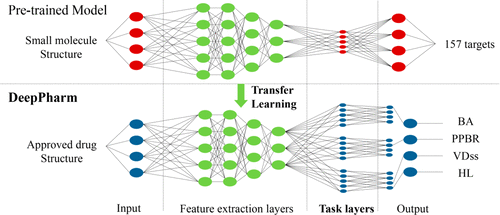当前位置:
X-MOL 学术
›
Mol. Pharmaceutics
›
论文详情
Our official English website, www.x-mol.net, welcomes your
feedback! (Note: you will need to create a separate account there.)
An Integrated Transfer Learning and Multitask Learning Approach for Pharmacokinetic Parameter Prediction
Molecular Pharmaceutics ( IF 4.5 ) Pub Date : 2018-12-20 00:00:00 , DOI: 10.1021/acs.molpharmaceut.8b00816 Zhuyifan Ye 1 , Yilong Yang 1, 2 , Xiaoshan Li 2 , Dongsheng Cao 3 , Defang Ouyang 1
Molecular Pharmaceutics ( IF 4.5 ) Pub Date : 2018-12-20 00:00:00 , DOI: 10.1021/acs.molpharmaceut.8b00816 Zhuyifan Ye 1 , Yilong Yang 1, 2 , Xiaoshan Li 2 , Dongsheng Cao 3 , Defang Ouyang 1
Affiliation

|
Background: Pharmacokinetic evaluation is one of the key processes in drug discovery and development. However, current absorption, distribution, metabolism, and excretion prediction models still have limited accuracy. Aim: This study aims to construct an integrated transfer learning and multitask learning approach for developing quantitative structure–activity relationship models to predict four human pharmacokinetic parameters. Methods: A pharmacokinetic data set included 1104 U.S. FDA approved small molecule drugs. The data set included four human pharmacokinetic parameter subsets (oral bioavailability, plasma protein binding rate, apparent volume of distribution at steady-state, and elimination half-life). The pretrained model was trained on over 30 million bioactivity data entries. An integrated transfer learning and multitask learning approach was established to enhance the model generalization. Results: The pharmacokinetic data set was split into three parts (60:20:20) for training, validation, and testing by the improved maximum dissimilarity algorithm with the representative initial set selection algorithm and the weighted distance function. The multitask learning techniques enhanced the model predictive ability. The integrated transfer learning and multitask learning model demonstrated the best accuracies, because deep neural networks have the general feature extraction ability; transfer learning and multitask learning improve the model generalization. Conclusions: The integrated transfer learning and multitask learning approach with the improved data set splitting algorithm was first introduced to predict the pharmacokinetic parameters. This method can be further employed in drug discovery and development.
中文翻译:

药物动力学参数预测的集成转移学习和多任务学习方法
背景:药代动力学评估是药物发现和开发中的关键过程之一。但是,当前的吸收,分布,代谢和排泄预测模型的准确性仍然有限。目的:本研究旨在构建整合的转移学习和多任务学习方法,以开发定量的结构-活性关系模型来预测四个人体药代动力学参数。方法:药代动力学数据集包括1104个美国FDA批准的小分子药物。数据集包括四个人类药代动力学参数子集(口服生物利用度,血浆蛋白结合率,稳态下的表观分布量和消除半衰期)。预训练模型在超过3000万个生物活性数据条目上进行了训练。建立了集成的转移学习和多任务学习方法,以增强模型的泛化能力。结果:药代动力学数据集通过具有代表性的初始集选择算法和加权距离函数的改进的最大相似度算法,分为三个部分(60:20:20)进行训练,验证和测试。多任务学习技术增强了模型的预测能力。集成的转移学习和多任务学习模型表现出最好的准确性,因为深度神经网络具有通用的特征提取能力。转移学习和多任务学习提高了模型的泛化能力。结论:首先引入了集成的转移学习和多任务学习方法以及改进的数据集拆分算法来预测药代动力学参数。该方法可以进一步用于药物发现和开发中。
更新日期:2018-12-20
中文翻译:

药物动力学参数预测的集成转移学习和多任务学习方法
背景:药代动力学评估是药物发现和开发中的关键过程之一。但是,当前的吸收,分布,代谢和排泄预测模型的准确性仍然有限。目的:本研究旨在构建整合的转移学习和多任务学习方法,以开发定量的结构-活性关系模型来预测四个人体药代动力学参数。方法:药代动力学数据集包括1104个美国FDA批准的小分子药物。数据集包括四个人类药代动力学参数子集(口服生物利用度,血浆蛋白结合率,稳态下的表观分布量和消除半衰期)。预训练模型在超过3000万个生物活性数据条目上进行了训练。建立了集成的转移学习和多任务学习方法,以增强模型的泛化能力。结果:药代动力学数据集通过具有代表性的初始集选择算法和加权距离函数的改进的最大相似度算法,分为三个部分(60:20:20)进行训练,验证和测试。多任务学习技术增强了模型的预测能力。集成的转移学习和多任务学习模型表现出最好的准确性,因为深度神经网络具有通用的特征提取能力。转移学习和多任务学习提高了模型的泛化能力。结论:首先引入了集成的转移学习和多任务学习方法以及改进的数据集拆分算法来预测药代动力学参数。该方法可以进一步用于药物发现和开发中。











































 京公网安备 11010802027423号
京公网安备 11010802027423号